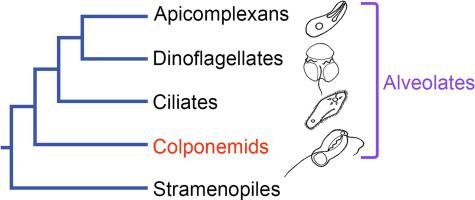当前位置:
X-MOL 学术
›
Mol. Phylogenet. Evol.
›
论文详情
Our official English website, www.x-mol.net, welcomes your feedback! (Note: you will need to create a separate account there.)
Predatory colponemids are the sister group to all other alveolates.
Molecular Phylogenetics and Evolution ( IF 4.1 ) Pub Date : 2020-04-21 , DOI: 10.1016/j.ympev.2020.106839 Denis V Tikhonenkov 1 , Jürgen F H Strassert 2 , Jan Janouškovec 3 , Alexander P Mylnikov 4 , Vladimir V Aleoshin 5 , Fabien Burki 6 , Patrick J Keeling 7
Molecular Phylogenetics and Evolution ( IF 4.1 ) Pub Date : 2020-04-21 , DOI: 10.1016/j.ympev.2020.106839 Denis V Tikhonenkov 1 , Jürgen F H Strassert 2 , Jan Janouškovec 3 , Alexander P Mylnikov 4 , Vladimir V Aleoshin 5 , Fabien Burki 6 , Patrick J Keeling 7
Affiliation

|
Alveolates are a major supergroup of eukaryotes encompassing more than ten thousand free-living and parasitic species, including medically, ecologically, and economically important apicomplexans, dinoflagellates, and ciliates. These three groups are among the most widespread eukaryotes on Earth, and their environmental success can be linked to unique innovations that emerged early in each group. Understanding the emergence of these well-studied and diverse groups and their innovations has relied heavily on the discovery and characterization of early-branching relatives, which allow ancestral states to be inferred with much greater confidence. Here we report the phylogenomic analyses of 313 eukaryote protein-coding genes from transcriptomes of three members of one such group, the colponemids (Colponemidia), which support their monophyly and position as the sister lineage to all other known alveolates. Colponemid-related sequences from environmental surveys and our microscopical observations show that colponemids are not common in nature, but they are diverse and widespread in freshwater habitats around the world. Studied colponemids possess two types of extrusive organelles (trichocysts or toxicysts) for active hunting of other unicellular eukaryotes and potentially play an important role in microbial food webs. Colponemids have generally plesiomorphic morphology and illustrate the ancestral state of Alveolata. We further discuss their importance in understanding the evolution of alveolates and the origin of myzocytosis and plastids.
中文翻译:

掠食性colponemids是所有其他肺泡酸盐的姐妹组。
肺泡是真核生物的主要超类,包括超过一万种自由生活和寄生的物种,包括在医学,生态和经济上很重要的apicomplexans,鞭毛虫和纤毛虫。这三类是地球上最广泛的真核生物,它们在环境上的成功可以与每一类中出现的独特创新联系在一起。了解这些经过精心研究和多样化的群体的出现及其创新很大程度上依赖于早期分支亲戚的发现和特征,这使祖先国家的推断更加可信。在这里,我们报告了一个组中三个成员colponemids(Colponemidia)的转录组中313个真核生物蛋白编码基因的系统生物学分析。它们支持其单亲和作为所有其他已知肺泡的姐妹血统的地位。来自环境调查和我们的显微镜观察的与colponemid相关的序列表明,colponemids在自然界中并不常见,但在世界各地的淡水生境中它们是多样且广泛的。研究的colponemids具有两种类型的挤压细胞器(毛囊或毒素囊),用于主动寻找其他单细胞真核生物,并可能在微生物食物网中发挥重要作用。colponemids通常具有plesiomorphic形态,并说明了肺泡的祖先状态。我们进一步讨论它们在了解肺泡的演变以及肌细胞增多症和质体起源方面的重要性。来自环境调查和我们的显微镜观察的与colponemid相关的序列表明,colponemids在自然界中并不常见,但在世界各地的淡水生境中它们是多样且广泛的。研究的colponemids具有两种类型的挤压细胞器(毛囊或毒素囊),用于主动寻找其他单细胞真核生物,并可能在微生物食物网中发挥重要作用。colponemids通常具有plesiomorphic形态,并说明了肺泡的祖先状态。我们进一步讨论它们在了解肺泡的演变以及肌细胞增多症和质体起源方面的重要性。来自环境调查和我们的显微镜观察的与colponemid相关的序列表明,colponemids在自然界中并不常见,但在世界各地的淡水生境中它们是多样且广泛的。研究的colponemids具有两种类型的挤压细胞器(毛囊或毒素囊),用于主动寻找其他单细胞真核生物,并可能在微生物食物网中发挥重要作用。colponemids通常具有plesiomorphic形态,并说明了肺泡的祖先状态。我们进一步讨论它们在了解肺泡的演变以及肌细胞增多症和质体起源方面的重要性。研究的colponemids具有两种类型的挤压细胞器(毛囊或毒素囊),用于主动寻找其他单细胞真核生物,并可能在微生物食物网中发挥重要作用。colponemids通常具有plesiomorphic形态,并说明了肺泡的祖先状态。我们进一步讨论它们在了解肺泡的演变以及肌细胞增多症和质体起源方面的重要性。研究的colponemids具有两种类型的挤压细胞器(毛囊或毒素囊),用于主动寻找其他单细胞真核生物,并可能在微生物食物网中发挥重要作用。colponemids通常具有plesiomorphic形态,并说明了肺泡的祖先状态。我们进一步讨论它们在了解肺泡的演变以及肌细胞增多症和质体起源方面的重要性。
更新日期:2020-04-21
中文翻译:

掠食性colponemids是所有其他肺泡酸盐的姐妹组。
肺泡是真核生物的主要超类,包括超过一万种自由生活和寄生的物种,包括在医学,生态和经济上很重要的apicomplexans,鞭毛虫和纤毛虫。这三类是地球上最广泛的真核生物,它们在环境上的成功可以与每一类中出现的独特创新联系在一起。了解这些经过精心研究和多样化的群体的出现及其创新很大程度上依赖于早期分支亲戚的发现和特征,这使祖先国家的推断更加可信。在这里,我们报告了一个组中三个成员colponemids(Colponemidia)的转录组中313个真核生物蛋白编码基因的系统生物学分析。它们支持其单亲和作为所有其他已知肺泡的姐妹血统的地位。来自环境调查和我们的显微镜观察的与colponemid相关的序列表明,colponemids在自然界中并不常见,但在世界各地的淡水生境中它们是多样且广泛的。研究的colponemids具有两种类型的挤压细胞器(毛囊或毒素囊),用于主动寻找其他单细胞真核生物,并可能在微生物食物网中发挥重要作用。colponemids通常具有plesiomorphic形态,并说明了肺泡的祖先状态。我们进一步讨论它们在了解肺泡的演变以及肌细胞增多症和质体起源方面的重要性。来自环境调查和我们的显微镜观察的与colponemid相关的序列表明,colponemids在自然界中并不常见,但在世界各地的淡水生境中它们是多样且广泛的。研究的colponemids具有两种类型的挤压细胞器(毛囊或毒素囊),用于主动寻找其他单细胞真核生物,并可能在微生物食物网中发挥重要作用。colponemids通常具有plesiomorphic形态,并说明了肺泡的祖先状态。我们进一步讨论它们在了解肺泡的演变以及肌细胞增多症和质体起源方面的重要性。来自环境调查和我们的显微镜观察的与colponemid相关的序列表明,colponemids在自然界中并不常见,但在世界各地的淡水生境中它们是多样且广泛的。研究的colponemids具有两种类型的挤压细胞器(毛囊或毒素囊),用于主动寻找其他单细胞真核生物,并可能在微生物食物网中发挥重要作用。colponemids通常具有plesiomorphic形态,并说明了肺泡的祖先状态。我们进一步讨论它们在了解肺泡的演变以及肌细胞增多症和质体起源方面的重要性。研究的colponemids具有两种类型的挤压细胞器(毛囊或毒素囊),用于主动寻找其他单细胞真核生物,并可能在微生物食物网中发挥重要作用。colponemids通常具有plesiomorphic形态,并说明了肺泡的祖先状态。我们进一步讨论它们在了解肺泡的演变以及肌细胞增多症和质体起源方面的重要性。研究的colponemids具有两种类型的挤压细胞器(毛囊或毒素囊),用于主动寻找其他单细胞真核生物,并可能在微生物食物网中发挥重要作用。colponemids通常具有plesiomorphic形态,并说明了肺泡的祖先状态。我们进一步讨论它们在了解肺泡的演变以及肌细胞增多症和质体起源方面的重要性。



























 京公网安备 11010802027423号
京公网安备 11010802027423号